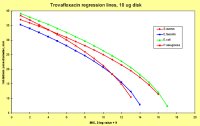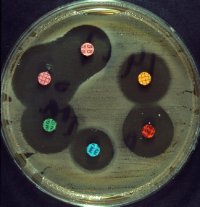|
Single strain regression analysis, SRA
One reason for using species-related interpretive breakpoints was
the fact that different species often gave different regression
lines, i.e. correlations between MIC values of isolates and their
inhibition zone diameter values in disc diffusion tests.
Calculating species-specific regression lines is possible using
Single-strain Regression Analysis, SRA.
SRA was originally developed in order to provide a tool for defining
interpretive zone diameter values corresponding to the MIC-limits
for susceptibility issued by reference authorities.
SRA is a formula describing the relation between disc content, MIC
value and inhibition zone diameter and is based on the original
equations developed during the 1950, as exemplified by the work
of
Cooper. The difference between the
SRA equation and the
regular regression line equation in comparison with the original
ones is that the SRA equation retains the amount of antibiotic in
the diffusion source as a variable. This adds an interesting feature.
When the MIC value of an isolate is known (for instance an official
reference or control strain) then a series of disc contents producing
different inhibition zone diameters will make it possible to calculate
the constants of the equation. Thereby, the regression line is also
defined. Moreover, this regression line was determined using only
one single strain and if this isolate behaves like most isolates
of that species it will also represent the regression line for that
particular bacterial species.
SRA therefore makes it possible to determine the regression lines
for different species and thereby also to set correct zone breakpoints
for different species corresponding to the MIC limits for susceptibility.
For an explanation of SRA, see
Kronvall & Ringertz, 1991.
Examples of breakpoint calculations using SRA:
Cephalothin, 1984
Doxycycline, 1985
Ceftazidime, 1985
Chloramphenicol, 1988
Norfloxacin , 1989, and
Ciprofloxacin, 1989
Gentamicin, 1981, and
for enterococci, 1991
Trovafloxacin, 1999, and
for anaerobes, 2000
Fusidic acid and C.difficile, 2000,
and for
Staphylococcus aureus, 2002
SRA was also applied to
cefoperazone results from
other authors to calculate interpretive breakpoints corresponding
to MIC limits for different species, not possible using regular
regression analysis.
The examples given above seem to indicate that calibration of the
disc diffusion test might be possible in the individual laboratory.
Such procedures are everyday tasks for the clinical chemist, but
the word calibration is not yet in the vocabulary of the clinical
microbiologist,
(see next page).
NEXT 
|

